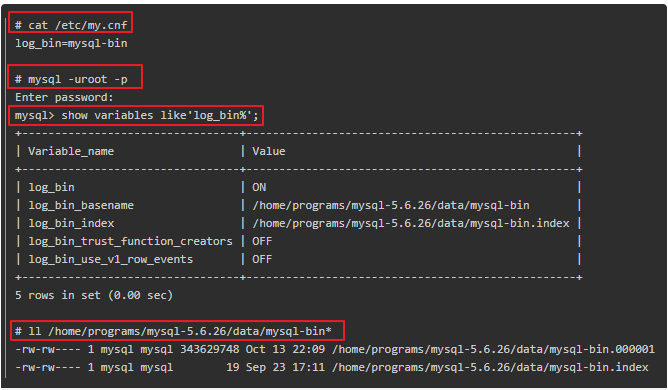Free Download MySQL Recovery Tool to Recover MySQL Database
2 Ways to Recover MySQL Database Files (with Pictures)
Don't worry if you lost files or data from the MySQL database. You can perform MySQL recovery with a tool, or with Binlog.
| Workable Solutions | Step-by-step Troubleshooting |
|---|---|
| 1. Recover MySQL with Reliable Tool |
|
| 2. Recover MySQL from Binlog |
|
What Is MySQL Database
A database is a structured collection of data. It may be anything from a simple shopping list to a picture gallery or the vast amounts of information in a corporate network. To add, access, and process data stored in a computer database, you need a database management system such as MySQL Server. Since computers are very good at handling large amounts of data, database management systems play a central role in computing, as standalone utilities, or as parts of other applications.

MySQL is a relational database management system (RDBMS) based on SQL (Structured Query Language). First released in January 1998, MySQL is now one component of parent company MySQL AB's product line of database servers and development tools. It is used in a wide range of applications, including data warehousing, e-commerce, Web databases, logging applications, and distributed applications. Now, it becomes the world's most popular open-source database because of its fast performance, high reliability, ease of use, and dramatic cost savings.
The Best MySQL Database Recovery Software (Recommended)
MySQL database files usually end with an extension of FRM, MYD, MYI. The *.frm files contain the table definitions. The *.myi files are MyISAM index files. The *.myd files contain the table data. Similar to other types of data, you may lose your MySQL files due to accidental deletion, careless formatting, partitions loss, system crash, and virus infection. Even when you make every effort to avoid it, the data loss misery still happens.
Then, how to recover MySQL data when the problem occurs but you don't a backup? Here, our advice is to try data recovery software. And we recommend Deep Data Recovery. It can deal with various data loss situations and recover the MySQL database file from it. Besides, it has many highlights:
Deep Data Recovery
- Recover deleted, formatted, and inaccessible data in different data loss situations.
- Recover files from formatted hard drive, emptied recycle bin, memory card, flash drive, digital camera, and camcorders
- Recover word files, photos, audio, music, and emails from any storage effectively.
How to Recover MySQL with Qiling MySQL Data Recovery Tool
Download this hard disk data recovery software and get back lost MySQL data as soon as possible. Launch it and follow the next simple steps to recover lost MySQL files.
Step 1. Run Deep Data Recovery on your computer. Select file types and click "Next" to start.

Step 2. Choose the drive where you lost files and click "Scan". If your lost files were on an external storage device, connect it to your computer firstly.

Step 3. The software will quickly scan the deleted files immediately, and then automatically perform a deep scan to find more lost files. After the scan is completed, you can use "Filter" to quickly filter specific file types.

Step 4. Click the "Preview" button or double-click on a file for a full preview. Finally, select the desired files, click "Recover" and choose another safe location to save all the files at once.
If you have other data loss problems, you can also download this MySQL file recovery software to get back pictures, videos, documents with simple clicks.
How to Recover MySQL from Binlog
The prerequisite for recovering data from Binlog is that the MySQL Binlog must be turned on. If the Binlog log is not turned on, ignore this method. You can check the MySQL configuration file if Binlog is enabled. The log location is generally in the /var/lib/mysql directory.
Step 1. log in to MySQL and use the command to view Binlog.
- # cat /etc/my.cnf
- # mysql -uroot -p
- mysql> show variables like'log_bin%';
- # ll /home/programs/mysql-5.6.26/data/mysql-bin*

Step 2. Find the wrong statement in Binlog.
You can find the execution time of the error statement in the Binlog, and restore the logs. You can also skip this step and directly restore the entire Binlog. Then, open the SQL file and delete the error statement.
- # sudo mysqlbinlog --base64-output=DECODE-ROWS -v -d ids --start-datetime '2016-10-11 15:22:53' mysql-bin.000001 > /home/stack/data.sql

Step 3. Recover MySQL from Binlog
Use MySQL Binlog command to directly restore the Binlog log to the SQL script, and you can specify the time of the start and the end.
If multiple Binlog files are generated from the last backup (it is recommended to refresh the Binlog files at the same time as the backup) until the recovery time. Then, export them to SQL and import them into the database in order from smallest to largest.
- # sudo mysqlbinlog --base64-output=DECODE-ROWS -v -d ids --start-datetime '2016-10-11 15:22:53' mysql-bin.000001 > /home/stack/data.sql

Step 4. Recover data to MySQL
When you are restoring data, there may be repeated data errors. It is recommended to use the -f parameter to ignore it.
- # mysql -uroot -p -f ids < data.sq

Conclusion
That's all about MySQL database. If you have enabled Binlog, Method 2 is recommended. If you don't have any backup, Method 1 is recommended. Qiling data recovery software can recover FRM, MYD, MYI files, and more.
Related Articles
- How to Recover Formatted Hard Drive/SD Card/USB Data Using CMD
- How to Recover Data from RAID 1 Disk with Raid 1 Recovery Software
- Top 6 Ways to Fix Windows 10 WHEA Uncorrectable Error
- Free SanDisk Recovery Software Recovers Lost Sandisk Data